Author: Joyeeta Mookherje
Creative, enthusiastic Digital Marketing Specialist and blogger at Inovar Consulting. She is passionate about her work and willing to learn in order to excel in the professional field. A singer, animal lover and friendly person to interact with.
Digital transformation is the integration of digital technology into all areas of a business, fundamentally changing how one operates and delivers value to customers. With all the service options a customer has nowadays, the relationship a service-provider has with its customers has never been more critical. Businesses must be agile and flexible to meet their evolving demands, and the onus is on these businesses to support those needs and streamline efficiency.
Additionally, a digital transformation strategy helps employees being more engaged. With updated systems, applications, and solutions, it’s easier to communicate with customers, partners, and co-workers, and it leads to better collaboration as well, helping them succeed in driving important business initiatives.

There are many ways that a company can gain benefit by instituting a digital transformation plan, some of which are short-term wins, while others become more obvious down the line. Here are the 6 critical factors that lead to success in Digital Transformation.
- Setting a strategy that covers what, why, and how and defines specific business outcomes
- Winning leadership commitment from CEO through middle management
- Finding the most capable people to drive the program
- Developing an agile governance mindset that is flexible and adaptable.
- Establishing clear metrics for processes and outcomes
- Building modular tech and data platforms driven by business needs

The key to addressing all six factors is planning, preparation, and execution of digital transformation strategy. Once the plan is fixed, then one can determine what it is that one wants to gain from upgrading the digital foothold. Digital Leaders have accomplished an earnings growth 1.8 times* higher than companies that resist Digital Transformation. Organizations that get these 6 elements right have an 80%* chance of success.

Out of the six factors mentioned, two of them are the most critical:
Agility is the key – Organizations need to ensure that all operations adopt an agile approach to work. This means learning continuously, acting as one team, being outcome-oriented, and being committed to action. While making this shift, having an agile mindset is of utmost importance. This requires an authentic belief in the behavioural changes required, as well as supporting tools such as playbooks, processes, and support to work in a cross-functional, mission-oriented way.
Soft skills are as important as tech skills – Another key factor is spending enough time to get the right people in place and then supporting those people. Leaders need to find the best people with the highest potential to lead a successful transformation. A few things to assess when finding a transformation team are:
- Have you taken extra care to fill pivotal roles such as program manager?
- Are there enough digitally literate people to drive new thinking?
- Have you sourced team members tactically from business units so that they can become champions in critical areas?
- Do you have a detailed assessment of the skills required and gaps to be filled?

In addition to tracking progress toward goals, company leaders should track the momentum of the project. Digital Transformation leaders should ask these questions to measure momentum:
- How strong is the business pull for digital solutions versus the program push?
- How do the most talented people in the company feel about joining the program, wary or excited?
- Are executives diverting funding to other initiatives or defending the transformation project?
- Are people trying to lower expectations about the work or talking up the advancements?
These “threshold behaviours” are a good indicator of whether the work is headed in the right direction or stalled out. Success is measured by the percentage of targets met and value created, the percentage of goals met on time, success relative to other transformations, and success relative to management’s aspirations for sustainable change.
InovarTech eliminates the complexity of end-to-end integration with a modern cloud integration platform that connects B2B Data flows, applications, and data across the entire ecosystem and drives complex digital transformation efforts.
References:
*6 ways to win at Digital Transformation from TechRepublic
Over the last few years, the telecom industry has witnessed a heavy decline in revenue in core areas like voice and text messaging along with severe competition from Over-The-Top Service providers. Today the telecom industry is poised to undergo Digital Transformation due to the swift emergence of IoT and 5G. By making the services customer-centric, improving efficiency, and adding high-value margins, they can move away from traditional services. Just as cloud computing has changed the world of data, it is now changing the way the telecom industry operates. Many organizations have started adopting cloud-hosted solutions to streamline data delivery and utilize a single supplier for voice & data services.
Telecom is a people-intensive industry, with a seasoned workforce that includes teams in offices, on trucks, and in retail storefronts. Being forced to work from home due to the ongoing pandemic has impacted their productivity and increased security and infrastructure risks for customers. Technology has transformed almost every sector across the globe and the telecommunications industry is no exception to it.
Here are a few solutions that we feel can cause a dramatic change in the telecom industry:
- 5G Network – The Network of Today and Tomorrow
There are billions of internet users around the globe and most of them prefer smartphones as their primary internet access point. With smartphones now helping users manage important tasks in their lives, consumers look for high capacity networks that promise faster access to applications and richer services. Telecom giants, with the help of various technologists, have already started rolling out their 5G to a multitude of industries such as healthcare, automobile, and education. This expansion of telecom into all sectors by automating processes for online customers is what can bring back the telecom industry to its true potential.

- Managing Big Data
IoT enables telecom companies to acquire an enormous amount of data with the help of various sensors in mobile devices and apps. With the help of tech giants, companies can ensure that their network can move this data efficiently and continue to support new technologies. The data collected helps to generate crucial business insights and understand customer usage patterns which can ultimately be used to improve customer service and evaluate new products to optimize the network.
- Cloud adoption to unlock revenue stream
Most telecom providers rely on a large computing infrastructure to deliver a diverse set of applications, manage data, and bill services. Migrating to the cloud reduces internal computing resource needs as well as internal costs while increasing revenue streams. The pay-per-use service model helps telecoms to introduce new services, reduce the cost of the service, and work more effectively as per the market demands. By adopting cloud technology, telecom industries can switch important business functions to the cloud and benefit from its efficiency.

- Cybersecurity
The telecom sector is one of the most vulnerable sectors when it comes to cybersecurity. With telecom companies having a large customer base, there are abundant opportunities for malicious attacks to gain unauthorized access to their data. The consequences of infrastructure under attack could potentially affect a whole country and its government agencies. Thus, by adopting a holistic approach, telecom providers are able to detect threats, take up prevention measures, and support resilience when attacked.
- Robotic Process Automation (RPA)
The telecom industry has one of the highest adoption rates for RPA technology. It offers high levels of scalability and agility as it takes over the repetitive and rule-based tasks or processes. This enables companies with the right tools to easily manage back-office work such as maintaining data integrity and security, employee salaries, marketing, and advertising, thus giving employees time to work on crucial tasks and develop deeper customer relationships.

- ChatBots to manage customer base
As the telecom industry is now slowly based heavily on technological advances, many are already using AI technology such as virtual assistants, chatbots, and tools to improve customer experience and satisfaction. These solutions provide an unmatched ability to process and analyze an enormous amount of big data that provides valuable insights to improve the quality of service and increase revenue.
The telecommunications industry has been relaying messages between individuals and businesses for over 2 centuries – even during crises. Stress tested for resilience during the past 200 years, this industry is sure to evolve and emerge even more prepared for the decades ahead. There are a lot of new trends in this growing world of the telecom industry, but they all rely on the fundamentals of technology as a niche. By being able to provide reliable technology with a focus on the clients, one may be able to expand exponentially in the future.
The public cloud is fast becoming the platform of choice for IT leaders and their line-of-business counterparts. While the pace of the move to on-demand IT continues to quicken, CIOs are faced with a bewildering option of providers and services. The absence of a common framework for assessing Cloud Service Providers (CSPs), combined with the fact that no two CSPs are the same, complicates the process of selecting one migration tool that is right for your organization. Majority rely on public cloud infrastructure due to a shared responsibility model such that the cloud service providers take care of the cloud itself while you focus on what’s in the cloud i.e. your data and applications. But how do you choose which public cloud provider will be helpful to your organization?
The field has a lot of competitors in it – mainly Amazon Web Services and Microsoft Azure dominate the cloud industry. AWS has been in the game the longest, capturing about 33%* of the market share with Microsoft in the 2nd position with 13% market shares. A superficial glance might lead you to believe that AWS has an unprecedented edge over Azure, but a deeper look will prove the decision isn’t that easy.

AWS has always had an unprecedented upper hand as it was first launched in 2002, whereas Microsoft did not step into the Cloud market till 2010. Azure was not very well received at first and there were many challenges as AWS had more capital, more infrastructure, and better, more scalable services than Azure did. Moreover, Amazon added more servers to its cloud infrastructure and made better use of economies of scale. This was a setback for Microsoft, but the tide soon changed. Microsoft revamped its cloud offering and added support to a variety of programming languages and operating systems. Thus, making their system more scalable and now Azure is one of the leading cloud providers in the world.
Both Azure and AWS technologies have, in their own way, contributed to the welfare of society. NASA used the AWS Platform to make its huge repository of pictures, videos, and audio files easily discoverable in one centralized location, giving people access to images of galaxies far away. The Azure IoT Suite was used to create the Weka Smart Fridge, – an implementation of the Internet of Things as a medical device to improve the storage and distribution of vaccines throughout the supply chain, in healthcare companies. This has helped non-profit medical agencies ensure that their vaccinations reach people who otherwise don’t have access to these facilities.
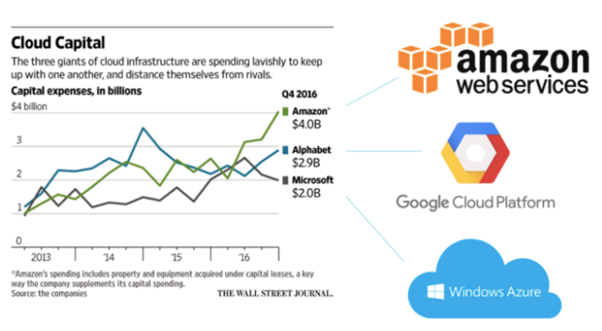
To determine the best cloud service provider, one needs to take multiple factors into consideration, such as cloud storage pricing, data transfer loss rate, and rates of data availability, among others. A few principal elements to consider for almost every organization while choosing the right tool to migrate are:
Security – Consider what security features are offered free out-of-the-box for each vendor you’re evaluating, which additional paid services are available from the providers themselves, and where you may need to supplement with third-party partners’ technology. Most tools make that process relatively simple by listing their security features, paid products, and partner integrations on the security section of their respective websites. Security is a top concern in the cloud, so it is critical to ask detailed and explicit questions that relate to your unique use cases, industry, regulatory requirements, and any other concerns you may have.
Compliance – Next make sure you choose a cloud architecture platform that can help you meet compliance standards that apply to your industry and organization. Whether you are beholden to GDPR, SOC 2, PCI DSS, HIPAA, or any other frameworks, make sure you understand what it will take to achieve compliance once your applications and data are living in a public cloud infrastructure. Be sure you understand where your responsibilities lie, and which aspects of compliance the provider will help you check off.
Architecture – When choosing a cloud provider, think about how the architecture will be incorporated into your workflows now and in the future. if your organization has already invested heavily in the Microsoft universe, it might make sense to proceed with Azure, since Microsoft gives its customers licenses and often some free credits. If your organization relies more on Amazon, then it may be best to look to them for ease of integration and consolidation. Additionally, you may want to consider cloud storage architectures when making your decision. When it comes to storage, both AWS and Azure have similar architectures and offer multiple types of storage to fit different needs, but they have different types of archival storage.
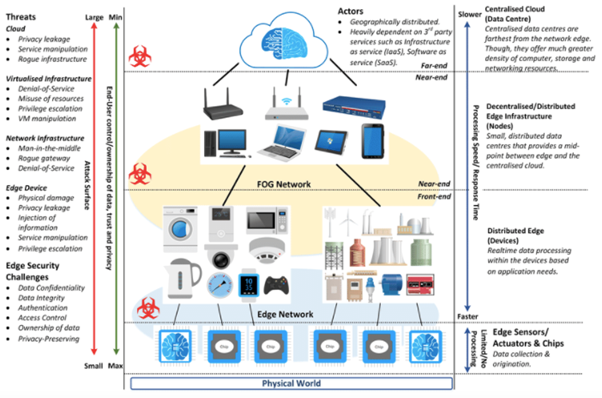
There are many motivations for evolving from an entirely on-prem infrastructure to a multiple or hybrid cloud architecture. From the very beginning of the cloud adoption process, hybrid cloud architectures allow enterprises to benefit from cloud economics and scalability without compromising data sovereignty. A multi cloud storage deployment also brings many benefits to the enterprise cloud, from avoiding vendor lock-in to accommodating mergers and acquisitions and optimizing price/performance.
Service Levels – This consideration is essential when businesses have strict needs in terms of availability, response time, capacity, and support. Cloud Service Level Agreements (Cloud SLAs) are an important element to consider when choosing a provider. It’s vital to establish a clear contractual relationship between a cloud service customer and a cloud service provider.
Costs – While it should never be the single or most important factor, there’s no denying that cost will play a big role in deciding which cloud service provider you choose. It’s helpful to look at both sticker price and associated costs. For AWS, Amazon determines price by rounding up the number of hours used. The minimum use is one hour. Azure bills customers on-demand by hour, gigabyte, or millions of executions, depending on the specific product. Serverless computing is a new cloud computing execution model in which the cloud provider runs the server, and dynamically manages the allocation of machine resources. Pricing is based on the actual amount of resources consumed by an application, rather than on pre-purchased units of capacity.

While the criteria discussed above won’t give you all the information you need, it will help you build a solid analytical framework to use when you are determining which cloud service provider you will trust with your data and applications. You can add granularity by doing a thorough analysis of your organization’s requirements to discover additional factors that will help you make an informed decision. This will be key to determining which provider will be the one that can deliver the features and resources that will best support your ongoing business, operational, security, and compliance goals.
References:
*How to choose your cloud provider: AWS, Google or Microsoft? Revived from : ThreatStack.com
Modern business users want tools that make them productive and engaged. Office365 is considered to be one such tool which is constantly evolving and moving towards Microsoft’s vision of the one-stop online-productivity hub. Microsoft SharePoint in Office 365 has now practically shaped the way organizations collaborate within their establishments. More than 75%* of Fortune 500 companies and over 100 million people across the globe now use SharePoint.
Earlier SharePoint was launched as an application for document management. But slowly, it evolved into document management and records management alongside web content and portals, thus turning into a robust collaboration and content management platform. With just a web browser, organizations could store, organize and share information accessible from any device.
Unlike the on-premises version, SharePoint Online is a Microsoft managed cloud solution that can be used for creating intranet and websites for public use. The biggest question that arises is why should businesses migrate to SharePoint Online? Not everyone is comfortable with this migration from SharePoint On-Premises to SharePoint Online, but the long-term rewards are endless.
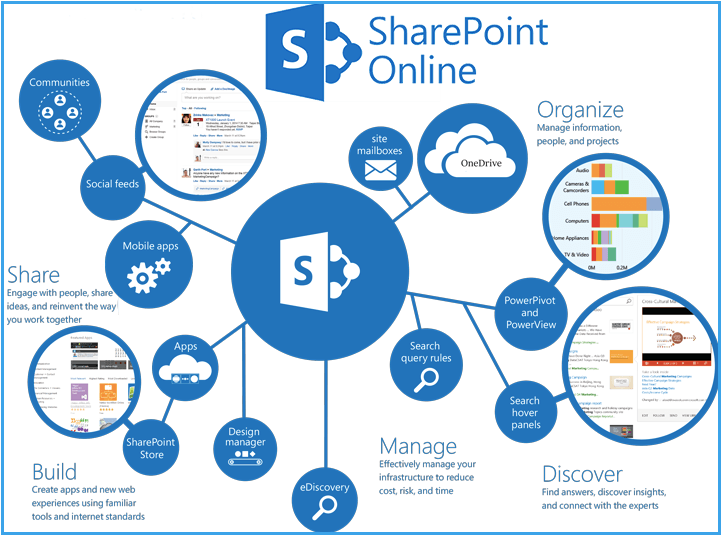
A few reasons why businesses should migrate to SharePoint Online are:
99.9% Guaranteed Uptime
This frees up the user to focus on the company’s performance instead of worrying about whether the services are reliable or not. With an outstanding support team, SharePoint online remains available around the clock for 365 days in a year.
Zero Server Footprint
SharePoint On-Premise required in-house teams for maintenance and technical support whereas all technical assistance for back-end processes in SharePoint Online is handled by the Microsoft Team. This means that all underlying hardware and platform problems, as well as, server upgrades and patches are covered by Microsoft. This is a major advantage as it becomes cost effective.
Enterprise Security Solutions
As SharePoint Online is managed by Microsoft, all users get enterprise-level security features to protect their confidential and sensitive data critical to their business. The data is stored in Microsoft’s data centers distributed around the globe and has 5 layers of Security, Proactive Monitoring and Operations Access Restriction, thus making it highly secure from the outside world.
External User Access Management
Managing security issues while allowing users to access SharePoint On-Premises is one of the major challenges in the legacy system. SharePoint Online simplified this process and made file sharing using Services Management Portal easier for collaboration.
Hybrid Environment
Businesses can continue to use their On-premises server while transitioning to the cloud to take advantage of SharePoint Online. This solution is perfect for businesses that are worried about compliance challenges such as data breaches if they move to the cloud model. While the most confidential business data can still be kept within the organization, others can be moved to the cloud for greater scalability.
Power Platform Ecosystem
Power platform is tightly integrated with SharePoint and provides you with the capability to create apps, automate business processes and visualize data. As Power Platform is a low code no code environment, getting started is easy but it doesnot limit you from building a full-scale mission critical solution.
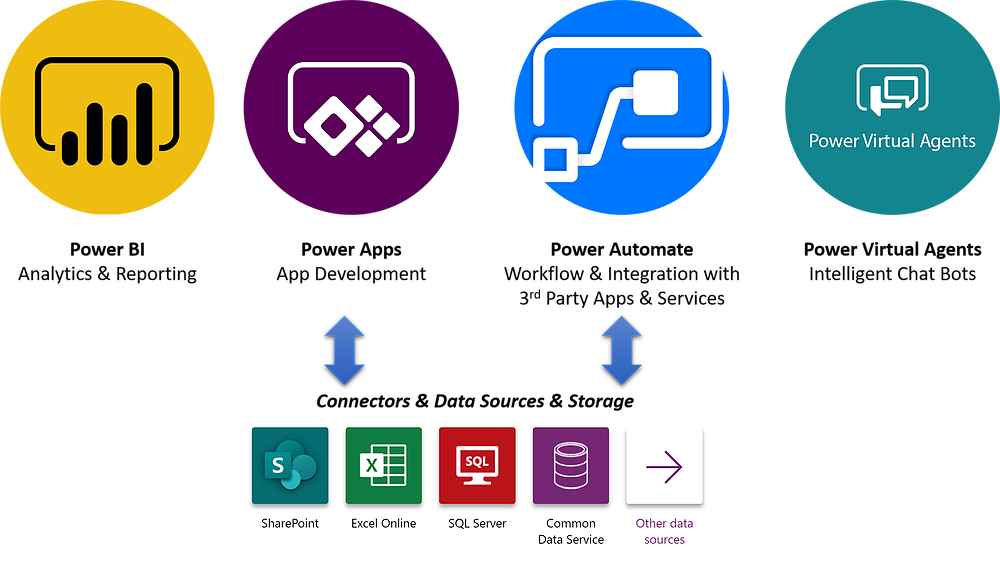
Evergreen Service
The latest features, patches, and security updates are available to all SharePoint Online users as soon as Microsoft makes them available. Whereas, these features are available on SharePoint On-Premise only in the next major release, so they remain stuck with the point release model. Since new features are automatically pushed to SharePoint Online, its users get to enjoy the upgrades much earlier.
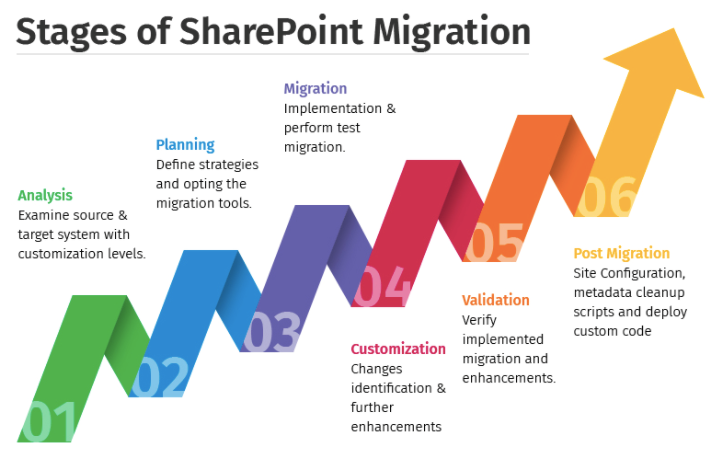
Enterprises invest a lot of money in SharePoint and concern themselves about reaping the benefits of their investment.
Based on a survey by 274 AIIM, 40%* SharePoint implementations are not successful.
A few challenges that organizations face when implementing SharePoint Online are:
User Adoption
User Adoption is a serious issue that many admins of SharePoint face in their organization. After deploying SharePoint, many enterprises replace file servers with document libraries, so that the indexing power of SharePoint helps in locating the documents quicker. But overloading document libraries makes the task tougher for the user to find the required information within the library.
User Interface
Intranets of SharePoint are inept with static pages and interactive tools. Some admins of SharePoint spent a lot of time and energy on customizing the intranet that can match the organization’s brand and provide a better user experience (UX).
Bulk Migration
It is quite possible that files may not end up in the correct location or can get corrupted during the migration. There is no general rule to take care of this but having similar file types maintained in specific folders helps. Also, there are third-party tools available in the market that are intelligent enough to identify and migrate content based on its type.
Loss of Metadata
While migrating, all or some metadata that was defined previously might get lost. To overcome this scenario, one must clearly define an inventory of the content, before starting the migration journey, and organize it well with the content types.
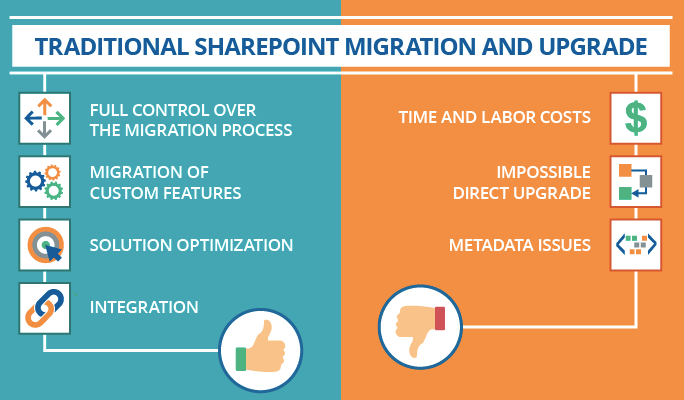
After analyzing all the benefits and challenges, another question that arises is what can one do to ensure a smooth migration? Users must spend time to analyze the content, their owners, the structure, and their importance. This shortens the overall migration timeline. Not only does this remove redundant and obsolete data but also helps prepare a governance plan.
SharePoint has transformed from a simple on-premises application into a comprehensive solution for collaboration, management of records and documents, and a system for managing portals and web content. It has helped countless businesses increase their productivity. The newer versions such as SharePoint Online cannot even be compared with the legacy versions that are incompatible with modern business requirements. Needless to say, migration from SharePoint On-Premise to SharePoint Online has become a necessity for modern features.
References:
*Top 5 rollout challenges faced by enterprises, April’20. Revived from: https://www.apty.io/blog/top-5-sharepoint-rollout-challenges-faced-by-enterprise